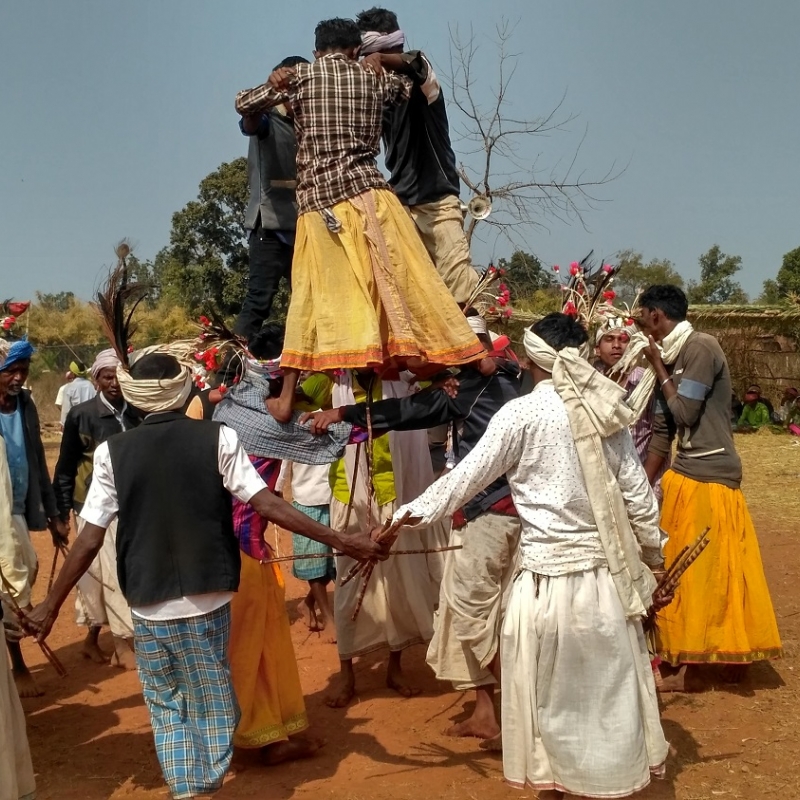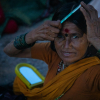The month of Pus/Poush is one amongst the two winter months in Uttar Bastar- Kanker. The winters in north Bastar are generally cool and pleasant in the mornings and gradually gets nippy after sun down. The month of Pus starts around the end of December and continues till the third week of January. With the winter moving into Pus and the harvesting season of paddy wrapping up; the young men of the Gond villages of north Bastar organize groups of dancers who ceremoniously travel to their neighbouring villages and perform dances while singing ‘rela’ songs dedicated to their cult leader ‘Lingo Pen’. They consider these songs to be charged with strong spiritual purpose and hence associate strict discipline and austerity with the performance. By the full moon of the month of ‘Pus’ the dancing party of men are expected to return to their own village and perform through the night singing and dancing for hours at a stretch to celebrate the spiritual endeavors of their ‘pen purkha’ (cult leader and ancestral deities) especially Lingo. Verrier Elwin called this event which lasted for over a fortnight as a ‘Ghotul expeditions’ undertaken by the youth of the Ghotuls. Today the Ghotuls have almost disappeared from the Muria villages of Uttar Bastar but the ‘Pus Kolang’ is still celebrated.
Understanding Kolang: The way it was Practiced in the Past
Lalit Nareti of Hanpatri village of Durgkondal writes that ‘Pus Kolang’ is a collection/ dance of the sticks. ‘Kolang’ is a derivative of the word ‘Kola’ or sticks. Young men dance with sticks made from the wood of ‘Dhawai’ (Woodfordia fruticosa) tree.
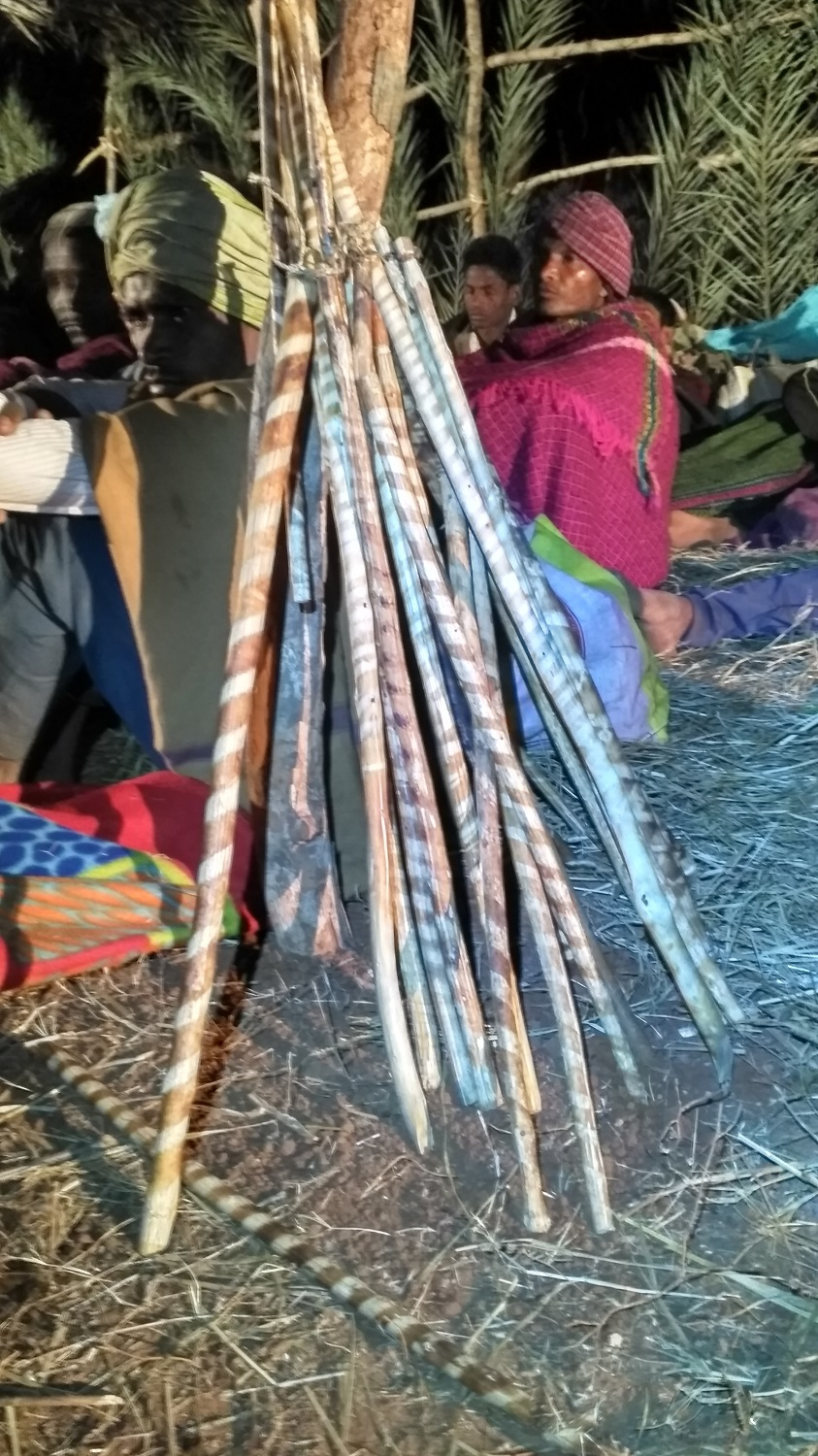
Kolang Sticks
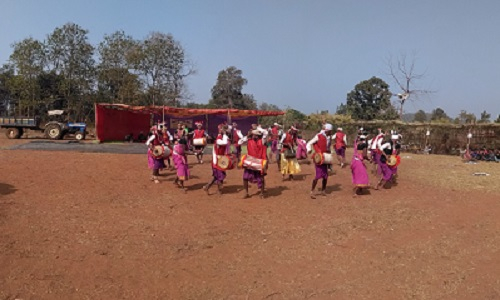
Dance Performance during Pus Kolang
Nareti writes that one needs to know the exact practice of the dance expedition to understand the underlying philosophy of it. In his brief write up Nareti says that before the Kolang expedition begins the leader of the Ghotul or a village elder selects member of the Ghotul whom he wants to join after him to repeat the song and dance with him. They practice the steps of the dance in the Ghotul, special sticks made of Dhawai are not used during this phase, however the dance is practiced with precaution to avoid making any mistake. It is believed that wrong steps of the Kolang dance can result in dire consequences ranging from serious disease to death or a loss of loved ones. After rehearsing and learning the steps when the dancing party is ready to depart, they approach the ‘gaita’ (head shaman/ priest) of the village and a departure ceremony is performed which is called ‘Hichelhar’; during this ceremony people form a circle and dance to rela songs, at times people form a tail like line emerging from the circle and dance. The songs of this ceremony speak of the different phases of life and the ever-changing body of the human being moving from the exuberance of youth to the decadence of old age. Right after the dance the selected party goes to the woods in search of Dhawai wood to make the special Kolang sticks. After the sticks are cut from the branches, the bark of the tree is used to wrap around the stick and it is roasted over fire. After roasting, the sticks get a distinct spiral pattern around them. Right before departure the dancing party reaches the house of the Gaita (ritual head) and performs the Kolang dance. On hearing the dance party perform the Gaita and his wife bless them with grains and some valuables (such as coins) the Gaita also summons the young women of the Ghotul and walk them down to the boundary of the village and performs another ceremony with grains and lama (Phyllanthus emblica or Indian gooseberry) leaves. During this ritual the women ask men through their songs a few questions and the men are expected to respond to them through songs. The ceremonious questioning and answering is called ‘daar geet’ in the local parlance. After the ceremony at the border of the village the dancing party is treated to some food and after eating, they depart to perform the Kolang Dance in their neighbouring villages.
The Dance and the Songs
Verrier Elwin informs us that the villages where the dancing expeditions will be organized is decided by the dancing party which visited last year. It depends on how the villagers of the visiting village treat the party. Another way is when the gaita through divine providence foresees certain need to visit some village. A custom is also popular where a dog accompanies the dance party since it is believed that Lingo pen comes in the form of a ‘dog’ and the party should dance in the places where the dog settles down. The beliefs vary from village to village but it still is a common sight to have a dog amongst the dance party.
The traditional Kolang songs, which were sung, talks of various things from what is to be adorned during the Kolang dances, where to dance and whom to address while dancing. The songs are in general sung with a rhyming ‘rela’. Verrier Elwin and more recently Komal Hupendi have written extensively on the Kolang songs; mostly from the songs and also through observation one can learn that the Chelik (male members of the Ghotul) wear extensive clothing and ornaments during the Kolang.
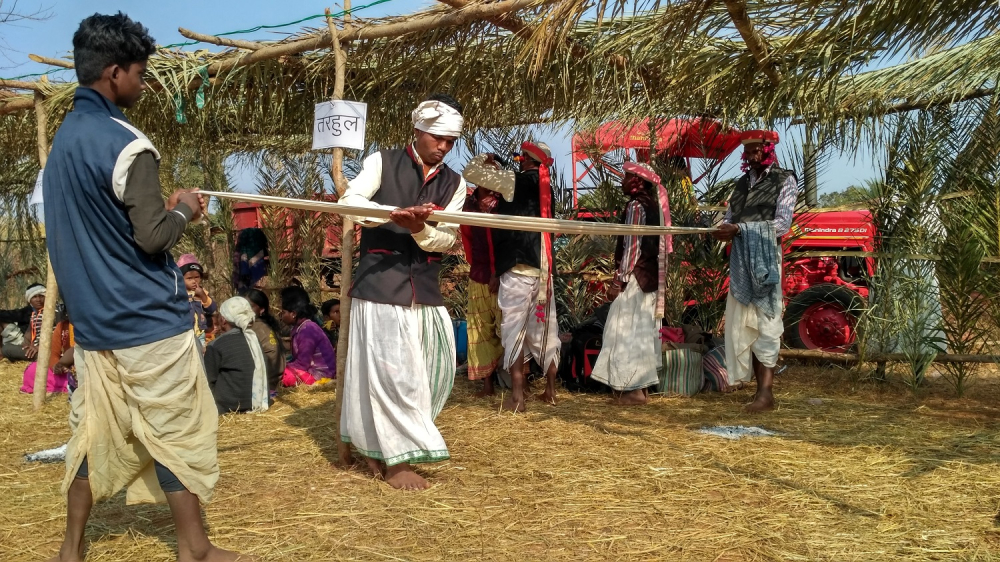
Preparing Turban for the Chelik before Kolang
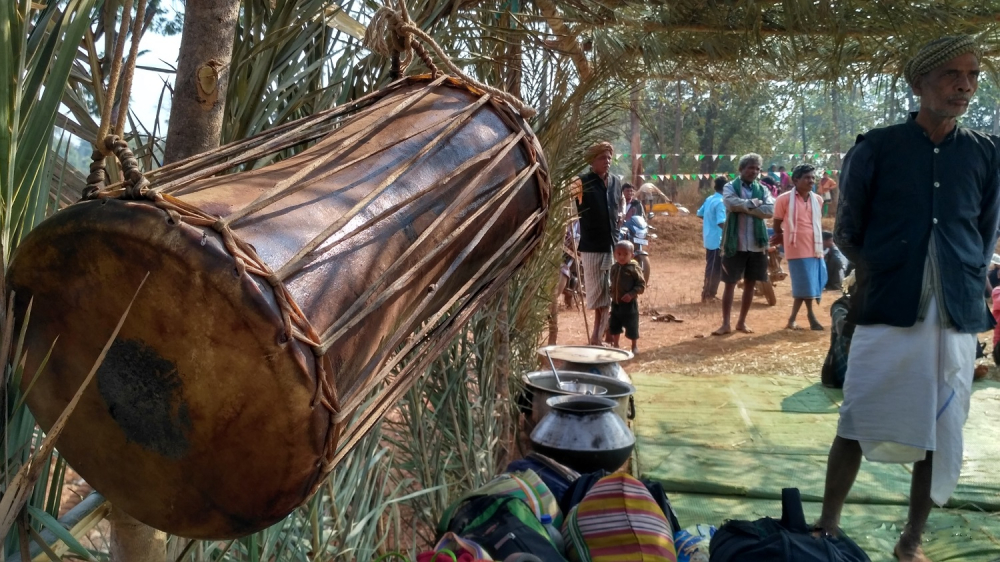
Mandar (traditional drum) Hanging Inside a Ghotul
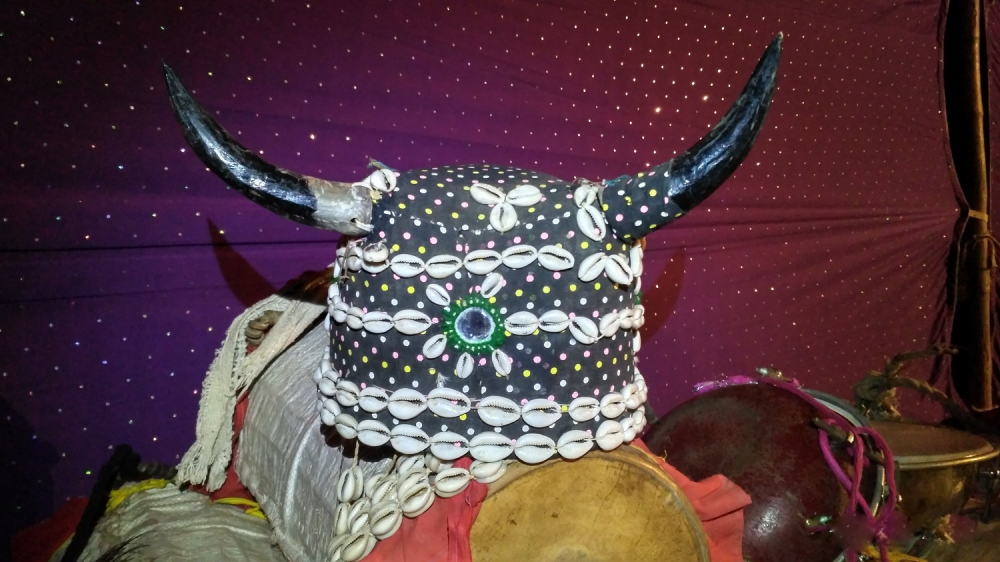
Bison-Horn Head Gear Worn during Kolang
The ‘Gain’ and the ‘Jokta’ (i.e., the leaders of the dancing party) adorn themselves with Lingo Singar (Elwin 1947) which is a combination of skirts and heavy ornaments and elaborate head gear ranging from a turban to ornamental caps made of bison horn. Most of the ornaments which are adorned rhyme and add to the music during the dance performance.
A common Kolang rela song as recorded by Hupendi describes the costume:
Re relo rela re rela re rela re...
Oh chelik
On the head you have the turban, On the turban you have feathers of the peacock.
Re relo rela re rela re rela re...
On your ears you have earrings...
Re relo rela re rela re rela re...
Around your neck necklaces of beads...
Re relo rela re rela re rela re...
Around your hands you have cuffs of silver
Re relo rela re rela re rela re...
On your fingers you have rings
Re relo rela re rela re rela re...
Around your waist you have bells
Re relo rela re rela re rela re...
Around your ankles you have rhyming anklets
Re relo rela re rela re rela re...
On your hands, oh chelik you hold the stick (Kolang Stick)
A few of the songs tells us a lot about their dance when the dancing party goes to another village. The songs say how the party looks for the house of the gaita of the visiting village and dance while chanting the praise of their cult leader, followed by the ancestral deities of the village and the region. They sing and ask the villagers about the gaita’s house and ceremoniously gets answered through the song itself...
Re rela rela re re rela rela re re rela rela re...
Show us the gaita’s house...Show us the gaita’s house
Don’t you know the gaita’s house chelik...don’t you know the gaita’s house...
Re rela rela re re rela rela re re rela rela re...
Where have you come from Chelik?
We have come from the land of hills
Re rela rela re re rela rela re re rela rela re...
If we show you what will you give us chelik?
We shall give you the cloth for your loins.
Re rela rela re re rela rela re re rela rela re...
It is the house with a cart in the yard, chelik.
There is a pond for the buffaloes in front, chelik.
That’s the Gaita’s house chelik.
Re rela rela re re rela rela re re rela rela re...
On the bamboo pole there is a monkey chelik.
There is an elephant tied to the pillar, chelik
A horse tied in the shed, chelik
On the roof there sits a peacock, chelik
There is a gun against the fence, chelik
A sword against the wall, chelik
A parrot on its perch, chelik
A myna in a cage, chelik
That’s the gaita’s house chelik... (written as appears in Elwin 1947)
While some songs blend a little humor with spiritual austerity some others are purely sung in celebration of the ancestral deities: ‘Johar Johar Burhal pen, Johar Johar Burhal pen....’
is one such chant which dancers keep chanting as they dance with their Kolang sticks.
The dancing party also needs to be careful of a long list of Do’s and Don’ts. They are threatened with severe consequences if the rules are not adhered to while they are in the Kolang expeditions.

A Youth from the Ghotul of Hilchur Out on a Kolang Expedition
The party is not supposed to go anywhere close to any domestic household, eat or drink from a married woman or have sexual encounters while they are visiting a village. They are also prohibited from crossing a fallen tree or eat food cooked by anyone else. They carry their own fire and cook the grains they collect; they sleep in pairs with their fellow dance party members and return to their own village when the full moon of Pus is up on the night sky.
As they return from their expedition a ceremony is performed before they enter the village by the gaita. It is performed so as to purge them of all spirits and forces which may have come with them to their village. The dance continues in their own Ghotul through the night and before the full moon of pus is over the ceremonial dance sticks are relieved of the possession/influence of their cult leader Lingo. The ceremony is called ‘Thanda karna’ literally to cool the sticks down from their spiritually energized states. This ceremony is also performed with utmost care as the sticks are hung from the thorns of ‘Semur tree’ after the final dance is performed at the village gaita’s place and also at their own Ghotul.
After the closer ceremony all the grains that the cheliks get home to their Ghotul from their expeditions are milled by the motiari and the next day a great feast is organized. After the feast the chelik and motiari are free from their taboos/rules associated with the Pus Kolang expeditions and can return to them.
Pus Kolang Today
Traditionally the Pus Kolang has been a major activity in the calendar of a Muria Ghotul. However, today the Ghotuls have almost disappeared. In the post-independence era, the Ghotul was portrayed to the external world in a negative light by the administrators and various ‘civilizing mission’ exerted moral pressure over the contemporary generations of Murias who gradually started dissociating themselves from Ghotuls. Researchers such as B R Rizvi wrote a scathing critique of the administration’s double standards with the institution of the Ghotul. Writing on tribal Development he underscores the fundamental reasons of the decay of the institutions such as Ghotuls and the associated activities such as Pus Kolang, Hulki or Diwari.
Rizvi writes:
The Muria Gonds still have the institution of Ghotul but it is dying fast. Ghotuls have already disappeared from the Murias living within a radius of 10 to 15km from Jagdalpur. It has been reported that the modern system of education, basically monopolized by high caste non-tribals, has instilled a sense of inferiority in the young children about the wrongly presumed free-sex activities of the Ghotuls. The modern yardstick of morality has pronounced a death sentence to this once highly organized, active and chivalrous institution that not only imparted training to the young about the tribal ethos but also acted as a corporate village labor force (Rizvi 1996)
a few lines later he adds:
Though non-tribals consider Ghotul as an undesirable institution but at times they do not hesitate to invite the Ghotul dancers to perform on festive occasions. The highly placed government officials and political leaders too are entertained by Ghotul dances in the coziness of government guest houses. In case some prominent guest expresses a wish to see a traditional Ghotul dance performance in the natural surroundings, they are obliged and taken to some few selected dormitories of Narayanpur. A fleet of cars reach a Muria village, the village head is called and a group of young dancers reach the village dormitory clad in dresses provided by the government for an instant half an hour dance performance...These instant performances are repeated in district headquarters, provincial capitals and national capitals...Their bodies are now covered with yellow sari and blouse and matching tufts of yellow flowers made of cotton.(Rizvi 1996)
Gradual alienation from the Ghotul and the lure of modernity has slowly taken its toll on the seasonal activities of the Ghotul such as the Pus Kolang. The cheliks and the motiaris are only temporary roles they are not residents of the Ghotul anymore. They remain in their respective households throughout the year and only occasionally and often nominally perform the dances. The rituals and the dances too have been reduced to stage performances. The ‘Kolang Layor’ (the Kolang dance party) these days only travel to those villages who host them or formally invite them. ‘The Gond Samaj’ a para-political body has also moved on with time and have undergone modernization at various levels. The operations of the Samaj are very similar to that of the state bureaucracy as most of the important positions are held by a small population of token bureaucrats who have emerged out of the Gond community as a result of affirmative action policies.
In most villages today the Kolang has become a ‘dance competition’ being organized by the local ‘Gond Samaj’ and neighbouring villages are invited to send in their dancing teams to compete. Prizes are also given out to the best performing teams. Many of these dancing teams perform dances which are not essentially Kolang dance forms. Only in a few villages which are relatively far away from the road side do we find some extant performances specific to Kolang. I stayed for a couple of days in a village approximately six kilometers inside from the roadside village of Dumkasa; the name of the hamlet was Helchur; there I stayed up all night when the Kolang Layor returned from their expedition and they danced in their makeshift Ghotul under the bright moonshine of the full moon of Pus. Such experiences are rare and would probably give way to more stage like performance in the coming years.
References:
Elwin, Verrier. Muria and their Ghotul. London: Oxford University Press, 1947
Rizvi, B.R. The Nehruvian Model of Tribal Development in Tribes of India ed by Rann Singh Mann: A Vision in Disarray. New Delhi: M. D Publications, 1996
Hupendi, Komal. Lingo na Daka. Uttar Bastar-Kanker: Janjatiya Sahitya Sadan, 2014
Nareti, Lalit. Kolang. Uttar Bastar- Kanker: Kupar Lingo Sewa Prabandha Samiti, 2016
This content has been created as part of a project commissioned by the Directorate of Culture and archaeology, Government of Chhattisgarh to document the cultural and natural heritage of the state of Chhattisgarh.
